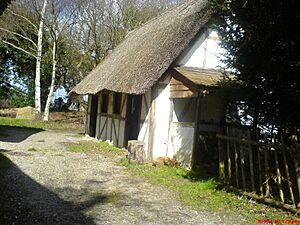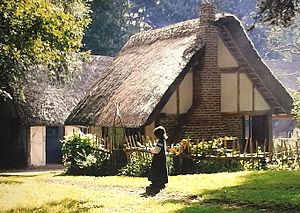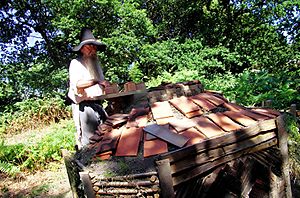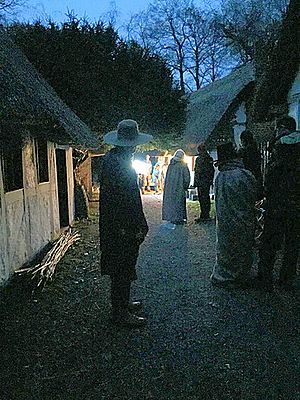Little Woodham facts for kids
Little Woodham is a special place often called "The Living History Village." It's like stepping back in time to a real village from the mid-1600s. This amazing living museum shows what life was like in a quiet, countryside village during that period. You can find it in old woodland near Rowner, on the Gosport peninsula in Hampshire, England.
Contents
A Look Back in Time: How Little Woodham Started
Little Woodham began in 1984. It was first created for a special event. Members of The English Civil War Society built it to show what village life was like just before the English Civil War. This was part of their reenactment of a made-up battle.
After the battle, volunteers from the Society kept the village open. They showed it to visitors during the summers of 1984 and 1985.
When the Society decided they couldn't continue, local people stepped in. They formed the Gosport Living History Society. Their goal was to keep the village going. They wanted it to be a place for learning and a fun tourist attraction.
The Gosport Borough Council helped a lot at first. They provided money and managed things until 1995. Then, the Gosport Living History Society became a registered charity. This meant they took full responsibility for the village. In 2007, Little Woodham even won an award. It was named "Best Leisure & Tourism Venue" in the "Go Gosport" awards.
What Makes Little Woodham Special?
Little Woodham has some truly unique features. These help visitors understand 17th-century life even better.
The Pottery Kiln
One amazing thing is the 17th-century replica pottery kiln. It's the only one of its kind in the world! It was built very carefully. The builders used the same materials and methods as people did hundreds of years ago.
The kiln was first fired in 2015. It has been used every year since then. All the pottery fired in it is made right there. Potters use a special kick wheel turntable, just like in the 17th century.
The Coal Forge
The 17th-century coal forge is another special recreation. Its design came from old clues. These included an archaeological dig of a blacksmith shop from 1622. Old paintings and drawings also helped.
Even though the forge is a new copy, the tools are very old. The anvils and other items used in the forge are hundreds of years old.
Blacksmith Experience Days
Little Woodham also offers "Forge Experience days." Visitors can spend a day working in the 17th-century coal forge. A blacksmith from Little Woodham guides them. They learn traditional skills using steel and wrought iron. They also see real 17th-century examples of ironwork.
Other Trades and Crafts
Many other interesting trades and crafts are shown throughout the village. You can see weavers making cloth and dyers coloring wool. There's also a wood turner, a button maker, and an apothecarist. An apothecarist was like an old-time pharmacist. You might also meet a scribe, a trickster, and a barber surgeon. These are just some of the many skilled people you can find!
Events at Little Woodham
Little Woodham hosts several exciting events each year. These events bring the 17th century to life even more.
May Day Celebrations
On May Day, the village is full of fun. There's story-telling and beautifully decorated houses. You might even see the Green Man and the Hobby horse characters.
Kiln Firing Day
The 17th-century Kiln firing is a must-see event. The Master Potter loads and fires the unique kiln. This is the only working 17th-century replica kiln in the world. All the pottery inside was made in the village's workshop. It was shaped using a traditional kick wheel.
Craft Day
Craft Day is a busy time in the village. Leather workers, walking stick makers, and potters are all at work. You can also see blacksmiths, weavers, woodworkers, and quilters. They all show off their amazing skills.
Filming at Little Woodham
Little Woodham is a popular spot for filming. Many film companies have used it as a location. These include major channels like BBC, Channel 4, and Channel 5. Independent film companies from around the world also film there. It's also a favorite place for many film students. They often use the village for their projects.








